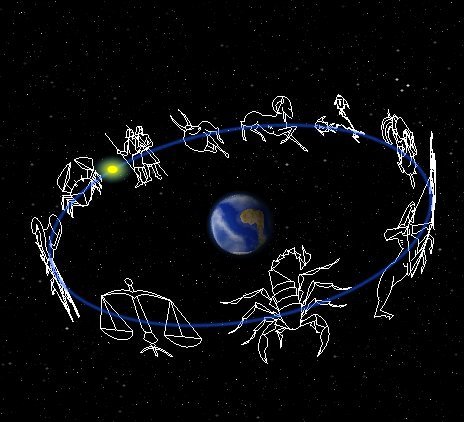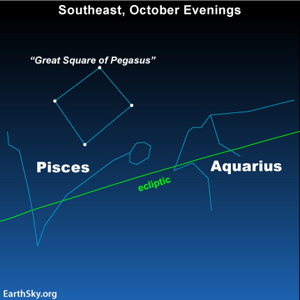Find constellations of the Zodiac on October evenings

TONIGHT FOR OCTOBER 3, 2012
Today’s sky chart shows the constellations of the Zodiac that are up after nightfall on these October evenings. In a separate chart below, we show the positions of the zodiacal constellations Aquarius and Pisces relative to the Great Square of Pegasus. We got this question: I’m having a difficult time being able to recognize the constellations of the Zodiac … do you have any advice?
Yes … we can recommend a few things.
First, the zodiacal constellations are the backdrop for the pathway of the sun around our sky each year, and of the moon for every month. Since the sun’s path lies within these constellations, you know you can look for them along the approximate path that the sun follows during the day – from east to west across the sky.
What is the ecliptic?
What is the Zodiac?

The sun, moon and planets all appear in our sky as if they travel within the boundaries of the constellations of the Zodiac.
Second, be mindful of the moon’s place in the sky, because it passes in front of each constellation of the Zodiac for a few days each month. For instance, on today’s date (October 3, 2012), the waning gibbous moon is rising around mid-evening and shining close to the border of the Zodiac constellations Aries and Taurus. That places the moon fairly close to the Pleiades star cluster.
For binocular astronomers: If you don’t see the tiny, dipper-shaped Pleiades star cluster in the moon’s glare tonight, try using binoculars.

You can use Jupiter to locate Zodiac constellations. But first you have to find Jupiter. On the nights of October 3, 4 and 5, notice Jupiter as the brightest object near the moon. This photo is from tonight (October 3, 2012) via our friend Annie Lewis in Madrid, Spain. Jupiter is the brightest starlike object in this photo. See the V-shaped pattern of stars near it? That’s the Face of the Bull in Taurus. This V pattern will be near Jupiter for many months to come.

The Great Square of Pegasus, autumn's easy-to-recognize star formation, can help you find Aquarius and Pisces
Third, as the years go by, pay special attention to the planet Jupiter, the fourth-brightest heavenly body to light up the sky. It is often called the year star because this planet stays in the same constellation of the Zodiac for approximately one year. At present, Jupiter is shining in front of the constellation Taurus, not far from the star depicting the Bull’s eye, Aldebaran. At this time next year, Jupiter will be in front of the constellation Gemini the Twins. By watching Jupiter from year to year, you can pick out the various zodiacal constellations.
Also, how dark is your night sky? If you’re looking from the city or suburbs, you might not be able to pick out these patterns in the sky. After all, these patterns were identified by people who didn’t have electric lights!
Do you have a good star chart? There are wonderful sky charts on the market today. You might try looking at the shop pages of Sky and Telescope magazine. For constellations, we recommend this simple constellation chart. Just be sure you find something that specifically refers to constellations and not just stars, if that’s what you’re after. Some charts are designed more for people with telescopes, but there are also good books and charts aimed at beginners.
Once you begin to learn the constellations, one will lead to another. For example, you can use the signpostSummer Triangle, which is high in the south to overhead at nightfall on October evenings, to find constellations of the Zodiac. As seen from the Northern Hemisphere, the ecliptic swings waybelow the Summer Triangle. An imaginary line drawn from the bright star Vega through the star Altair points in the general direction of Sagittarius, and a line drawn from Deneb through Altair escorts you to Capriciornus.
As seen from the Southern Hemisphere, these same constellations of the Zodiac – Sagittarius and Capricornus – appear high in the sky instead of close to the horizon. As darkness falls, the Summer Triangle asterism appears “upside down” and low in the north to northwest sky.
A good constellation chart will also help you find the Great Square of Pegasus asterism, found in the east to southeast sky on these October evenings. The Great Square can help guide you to the zodiacal constellations Aquarius and Pisces, as shown on the sky chart at the top of this post.
Bottom line: The constellations of the Zodiac follow the sun’s path across the sky. They provide a backdrop to the sun throughout the year. As seen from the Northern Hemisphere on October evenings, look low in the south to find the constellations of the Zodiac swinging from east to west across the evening sky.

TONIGHT FOR OCTOBER 3, 2012
Today’s sky chart shows the constellations of the Zodiac that are up after nightfall on these October evenings. In a separate chart below, we show the positions of the zodiacal constellations Aquarius and Pisces relative to the Great Square of Pegasus. We got this question: I’m having a difficult time being able to recognize the constellations of the Zodiac … do you have any advice?
Yes … we can recommend a few things.
First, the zodiacal constellations are the backdrop for the pathway of the sun around our sky each year, and of the moon for every month. Since the sun’s path lies within these constellations, you know you can look for them along the approximate path that the sun follows during the day – from east to west across the sky.
What is the ecliptic?
What is the Zodiac?

The sun, moon and planets all appear in our sky as if they travel within the boundaries of the constellations of the Zodiac.
Second, be mindful of the moon’s place in the sky, because it passes in front of each constellation of the Zodiac for a few days each month. For instance, on today’s date (October 3, 2012), the waning gibbous moon is rising around mid-evening and shining close to the border of the Zodiac constellations Aries and Taurus. That places the moon fairly close to the Pleiades star cluster.
For binocular astronomers: If you don’t see the tiny, dipper-shaped Pleiades star cluster in the moon’s glare tonight, try using binoculars.

You can use Jupiter to locate Zodiac constellations. But first you have to find Jupiter. On the nights of October 3, 4 and 5, notice Jupiter as the brightest object near the moon. This photo is from tonight (October 3, 2012) via our friend Annie Lewis in Madrid, Spain. Jupiter is the brightest starlike object in this photo. See the V-shaped pattern of stars near it? That’s the Face of the Bull in Taurus. This V pattern will be near Jupiter for many months to come.

The Great Square of Pegasus, autumn's easy-to-recognize star formation, can help you find Aquarius and Pisces
Third, as the years go by, pay special attention to the planet Jupiter, the fourth-brightest heavenly body to light up the sky. It is often called the year star because this planet stays in the same constellation of the Zodiac for approximately one year. At present, Jupiter is shining in front of the constellation Taurus, not far from the star depicting the Bull’s eye, Aldebaran. At this time next year, Jupiter will be in front of the constellation Gemini the Twins. By watching Jupiter from year to year, you can pick out the various zodiacal constellations.
Also, how dark is your night sky? If you’re looking from the city or suburbs, you might not be able to pick out these patterns in the sky. After all, these patterns were identified by people who didn’t have electric lights!
Do you have a good star chart? There are wonderful sky charts on the market today. You might try looking at the shop pages of Sky and Telescope magazine. For constellations, we recommend this simple constellation chart. Just be sure you find something that specifically refers to constellations and not just stars, if that’s what you’re after. Some charts are designed more for people with telescopes, but there are also good books and charts aimed at beginners.
Once you begin to learn the constellations, one will lead to another. For example, you can use the signpostSummer Triangle, which is high in the south to overhead at nightfall on October evenings, to find constellations of the Zodiac. As seen from the Northern Hemisphere, the ecliptic swings waybelow the Summer Triangle. An imaginary line drawn from the bright star Vega through the star Altair points in the general direction of Sagittarius, and a line drawn from Deneb through Altair escorts you to Capriciornus.
As seen from the Southern Hemisphere, these same constellations of the Zodiac – Sagittarius and Capricornus – appear high in the sky instead of close to the horizon. As darkness falls, the Summer Triangle asterism appears “upside down” and low in the north to northwest sky.
A good constellation chart will also help you find the Great Square of Pegasus asterism, found in the east to southeast sky on these October evenings. The Great Square can help guide you to the zodiacal constellations Aquarius and Pisces, as shown on the sky chart at the top of this post.
Bottom line: The constellations of the Zodiac follow the sun’s path across the sky. They provide a backdrop to the sun throughout the year. As seen from the Northern Hemisphere on October evenings, look low in the south to find the constellations of the Zodiac swinging from east to west across the evening sky.

No comments:
Post a Comment